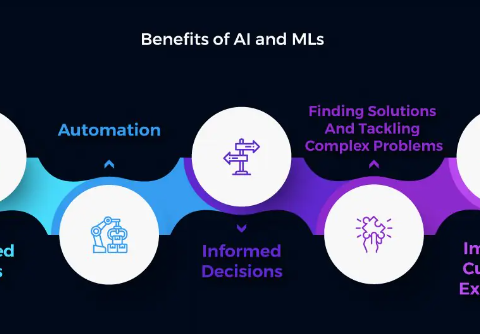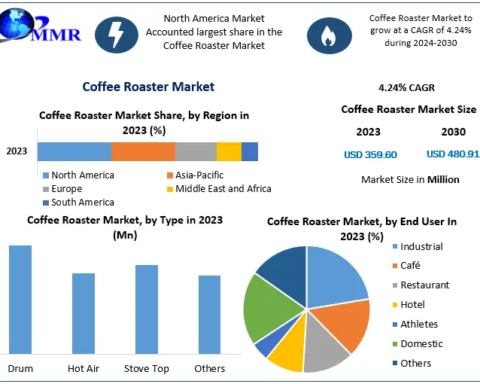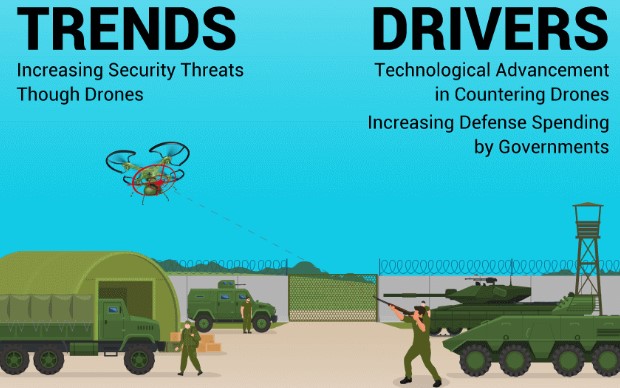In 2021, the global market for anti-drone technology was worth $1.34 billion. It is expected to increase to $1.58 billion in 2022 and reach $6.95 billion by 2029, growing at an annual rate of 23.55% during this period. The COVID-19 pandemic significantly boosted the demand for anti-drone solutions worldwide, leading to an 18.43% growth in 2020 compared to 2019, much higher than anticipated before the pandemic.
Informational Source:
https://www.fortunebusinessinsights.com/anti-drone-market-102593
Key Companies Covered in Anti Drone Market are:
- Raytheon Technology Corporation (U.S.)
- Lockheed Martin Corporation (U.S.)
- Israel Aerospace Industries (U.S.)
- DroneShield (Australia)
- Detect Inc (U.S.)
- Dedrone Holdings Inc. (U.S.)
- Liteye Systems Inc. (U.S.)
- Elbit Systems Ltd. (Israel)
- SaaB AB (Sweden)
- Thales Group (France)
As drone technology has become increasingly sophisticated and accessible, the need for effective anti-drone measures has grown significantly. Anti-drone systems are designed to detect, identify, track, and neutralize unmanned aerial vehicles (UAVs) that pose a threat to critical infrastructure, public safety, military operations, and other sensitive areas.
The rapid proliferation of commercial and hobbyist drones, coupled with their potential use for malicious purposes, has driven the development of a diverse range of anti-drone solutions. These technologies employ a variety of detection and countermeasure methods, including radio frequency (RF) monitoring, electro-optical/infrared (EO/IR) sensors, acoustic sensors, and kinetic and non-kinetic intercept systems.
Unique Developments in Anti-Drone Technology (August 2023)
-
Integrated Multi-Sensor Detection Systems:
- One of the latest advancements in anti-drone technology is the integration of multiple sensor modalities into a single, comprehensive detection system.
- These systems combine RF monitoring, EO/IR cameras, and acoustic sensors to provide a robust and redundant means of detecting and classifying drones.
- The integration of these sensors allows for improved target identification, reduced false alarms, and the ability to detect drones that may be using countermeasures to avoid detection by a single sensor type.
- Examples of such integrated systems include the AUDS (Anti-UAV Defense System) developed by a consortium of UK companies and the Drone Dome system from Rafael Advanced Defense Systems.
-
AI-Powered Drone Detection and Identification:
- The use of artificial intelligence (AI) and machine learning (ML) algorithms has become increasingly prevalent in anti-drone systems.
- These technologies enable advanced drone detection, classification, and tracking capabilities by analyzing data from various sensors.
- AI-powered systems can differentiate between drones and other flying objects, identify the make and model of detected drones, and predict their flight paths and intentions.
- This enhanced level of situational awareness allows for more effective countermeasure deployment and decision-making in response to drone threats.
- Examples include the Drone Hunter system from Fortem Technologies, which utilizes AI-powered radar and EO/IR sensors, and the DroneShield suite of products that incorporate AI-based drone detection.
-
Directed Energy Countermeasures:
- The development of directed energy-based anti-drone systems has gained significant traction in recent years.
- These systems use high-powered microwave (HPM) or laser technology to disrupt the electronic components or flight control of drones, effectively neutralizing the threat.
- Directed energy countermeasures offer several advantages, including the ability to engage multiple targets simultaneously, long-range engagement, and the potential for a non-kinetic response that minimizes collateral damage.
- Examples of directed energy anti-drone systems include the Pharos system from Raytheon and the Silent Guardian from Epirus, both of which have demonstrated the ability to disable drones at significant distances.
-
Counter-Swarm Capabilities:
- As drone technology advances, the threat of drone swarms, where multiple drones coordinate and operate as a single entity, has become a growing concern.
- Addressing this challenge, anti-drone systems are now being developed with the capability to detect, track, and neutralize drone swarms.
- These systems utilize advanced algorithms and coordination mechanisms to identify and engage multiple drones simultaneously, disrupting the cohesion and effectiveness of the swarm.
- Examples include the Drone Swarm Defeat System from Raytheon and the THOR (Tactical High-power Operational Responder) system from the U.S. Air Force Research Laboratory, which have demonstrated the ability to counter coordinated drone swarms.
-
Portable and Mobile Anti-Drone Solutions:
- In addition to fixed-site anti-drone systems, there has been a growing demand for portable and mobile anti-drone solutions that can be rapidly deployed to respond to emerging threats.
- These systems are designed to be easily transported and set up, allowing for the protection of temporary or dynamic locations, such as public events, military operations, or critical infrastructure.
- Examples include the Droneshield DroneGun Tactical, a handheld jammer that can disrupt drone control signals, and the Raytheon Coyote counter-UAS system, which can be mounted on vehicles or small boats for mobile deployment.
-
Drone Capture and Recovery Systems:
- While traditional anti-drone systems focus on neutralizing or disabling threats, there is an emerging interest in technologies that can capture and recover drones for forensic analysis or other purposes.
- These systems employ net-based or other non-destructive methods to physically apprehend drones, allowing for the potential identification of the operator and the drone’s intended use.
- Examples include the FALCON (Fast Lightweight Autonomy and Capture) system from the U.S. Defense Advanced Research Projects Agency (DARPA) and the SkyWall 100, a shoulder-mounted net-firing system from OpenWorks Engineering.
-
Integrated Command and Control Platforms:
- To effectively manage and coordinate the deployment of various anti-drone systems, integrated command and control (C2) platforms are being developed.
- These platforms consolidate data from multiple sensors and countermeasures, providing a centralized interface for threat detection, identification, and response coordination.
- By integrating different anti-drone technologies, these C2 systems enable a comprehensive and synchronized approach to counter-UAS operations, improving the overall effectiveness and efficiency of the defense.
- Examples include the Drone Portal from Dedrone and the Drone Defense System from Northrop Grumman, both of which offer integrated C2 capabilities for managing complex anti-drone operations.
-
Collaborative Multi-Domain Approaches:
- As the drone threat continues to evolve, the need for collaborative, multi-domain approaches to anti-drone defense has become increasingly apparent.
- This involves the integration of anti-drone systems with other defense and security assets, such as ground-based air defense systems, electronic warfare capabilities, and even counter-drone drones.
- By leveraging a diverse range of assets and coordinating their deployment, these multi-domain approaches enhance the overall resilience and effectiveness of counter-UAS operations.
- Examples of such collaborative efforts include the Joint Counter-Small Unmanned Aircraft Systems Office (JCO) in the United States, which coordinates the development and deployment of counter-drone technologies across different military and government agencies.
-
Advancements in Drone Detection and Tracking:
- Continued research and development in drone detection and tracking technologies have resulted in several unique advancements.
- These include the use of advanced radar systems, such as frequency-modulated continuous-wave (FMCW) radar, which can detect and track small drones more effectively than traditional pulsed-Doppler radar.
- Additionally, the integration of passive radar systems, which utilize existing electromagnetic signals in the environment, has emerged as a way to detect and track drones without the need for active transmission.
- Advancements in infrared and acoustic sensors have also improved the ability to detect and classify drones based on their unique thermal and acoustic signatures.
-
Regulatory and Policy Developments:
- Alongside the technological advancements, there have been significant regulatory and policy developments in the counter-drone domain.
- Governments and international organizations have implemented new regulations and guidelines to govern the use of anti-drone systems, addressing issues such as operator licensing, authorized deployment zones, and the use of force.
- These regulatory frameworks aim to balance the need for effective counter-drone measures with concerns about privacy, civil liberties, and the potential for misuse.
- Examples include the European Union’s Unmanned Aircraft Systems Regulation (EU 2019/947) and the U.S. Department of Homeland Security’s Counter-Unmanned Aircraft Systems Capability Catalog.
Conclusion
The rapid advancement of drone technology has driven the development of a diverse array of anti-drone solutions. From integrated multi-sensor detection systems and AI-powered identification to directed energy countermeasures and collaborative multi-domain approaches, the latest unique developments in anti-drone technology demonstrate the ongoing efforts to mitigate the growing threat posed by unmanned aerial vehicles.
As the drone landscape continues to evolve, the anti-drone industry will need to remain agile and innovative, adapting to emerging challenges and leveraging the latest technological breakthroughs. The successful integration of these advanced anti-drone systems, coupled with the implementation of effective regulatory frameworks, will be crucial in ensuring the safety and security of critical infrastructure, public spaces, and military operations in the years to come.











